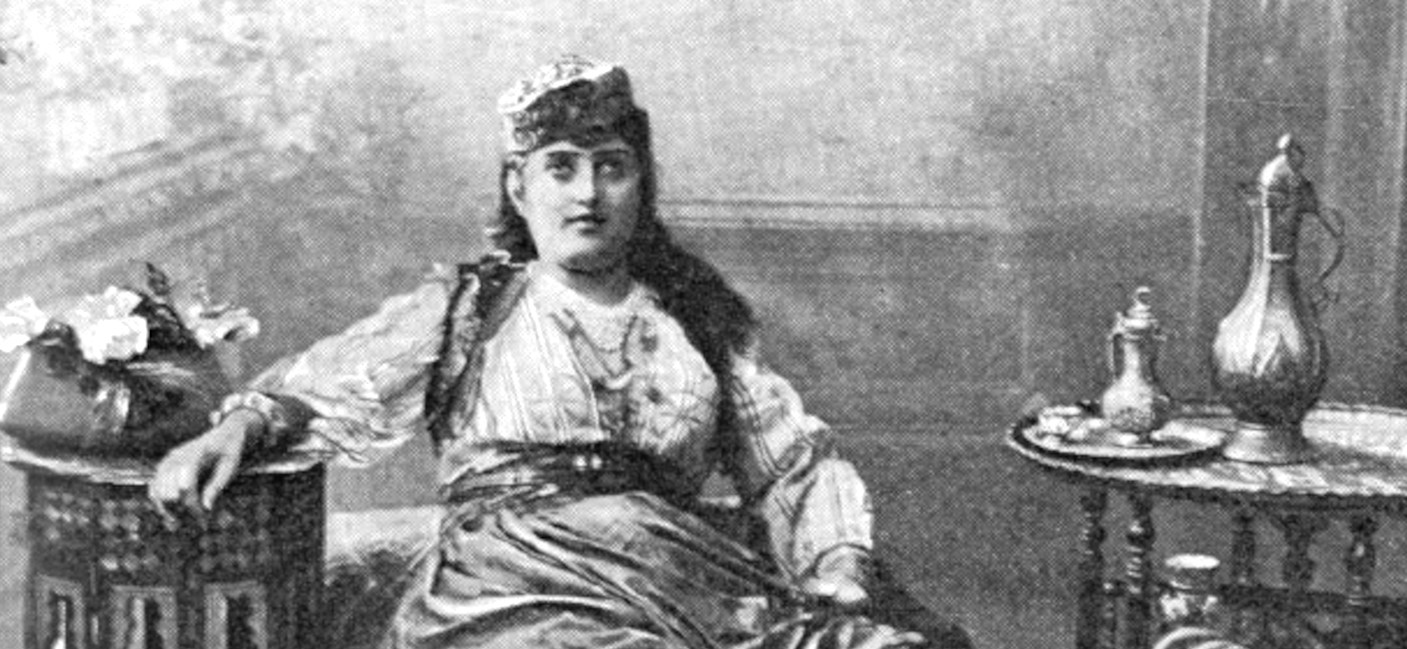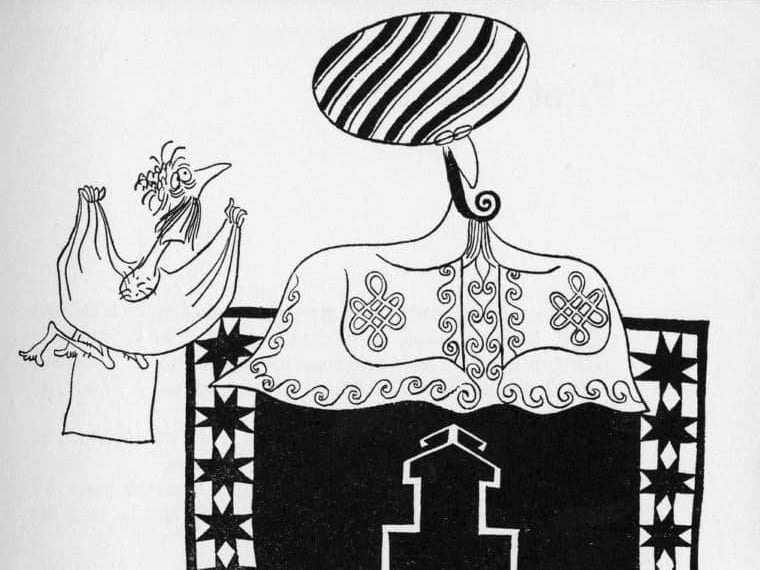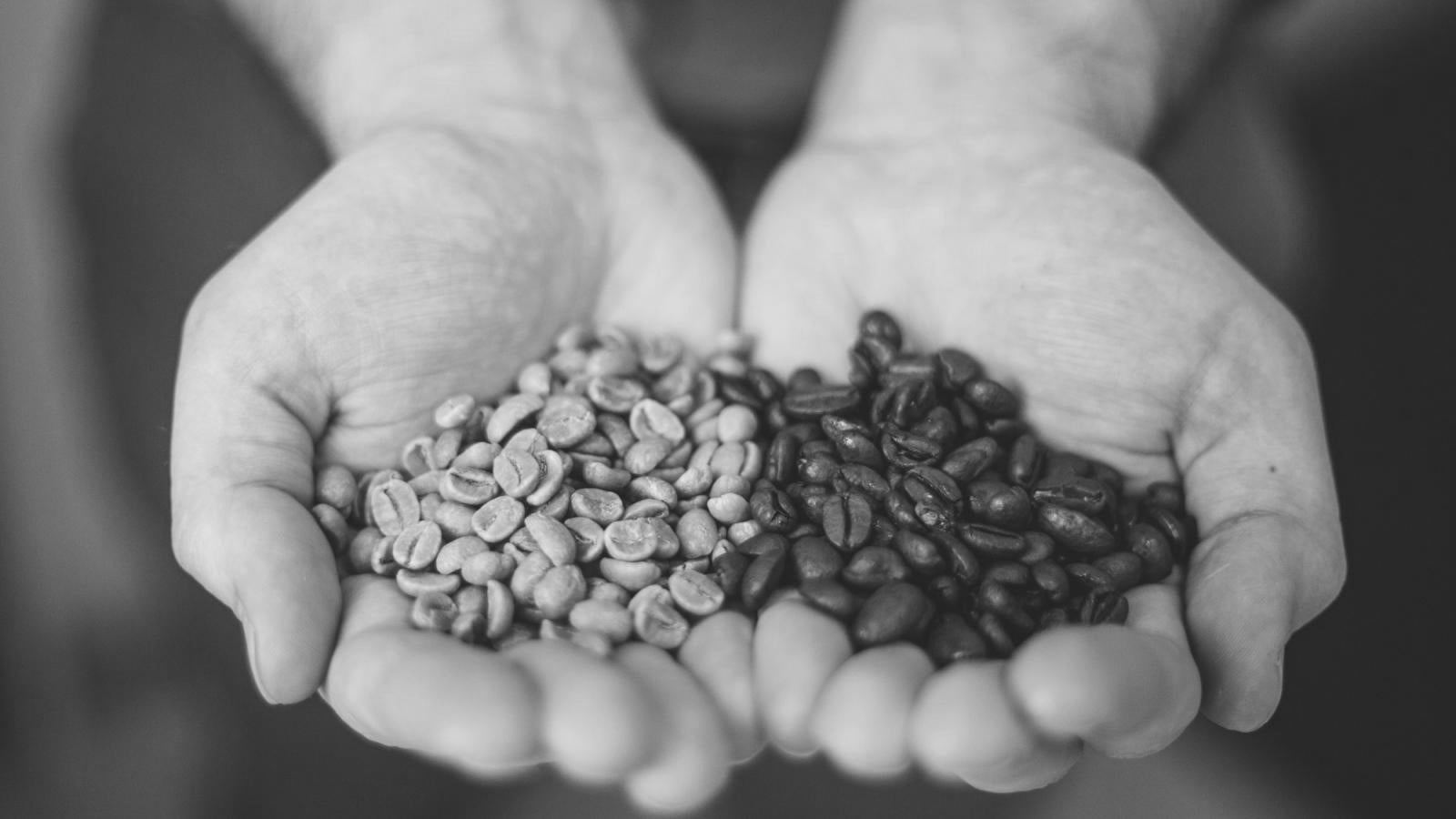The unique social fabric of the Italian bar is made by the locals, who meet there, share stories, and traditional coffee rituals. Bar culture is made of coffee lovers: an Italian espresso machine, a counter, a barista, and the sound of a tazzina (coffee cup) resting on the saucer.
In this Article
The reason Italy is thought to be one of the coffee hot spots of the world is the fact that the espresso machine and the Moka pot have been invented and perfected here.
A tiny cup of Italian bar history
Having a coffee al bar, is a frank moment between the public and the private, an informal meeting place in which to take a well-deserved break from the frenzy of the world.
The history of Italy’s caffè or bars – the small, family-run, ever quirky, warm-hearted places where you know you’ll get a wonderful coffee (and who knows what else) – is modern. Until around the late 1920s and early 1930s, the only coffeehouses were Grand Cafès. The history of the bar in Italy knows its moment of splendor in the middle of the nineteenth century, when the bourgeoisie used to find themselves at the coffee tables to savor worldliness.
In Italian, the word caffè is used for the beverage, mainly for espresso as well as for the coffeehouse, that in English it is also spelled cafè.
The grand coffee houses were opulent and luxurious, with chandeliers, huge mirrors, comfortable tables and chairs, and formally dressed waiters. The coffee house offered an island of gentile peace in the midst of the busy city, a place where businessmen could discuss finances and intellectuals philosophy and the state of the world while indulging in coffee and pastries.

Around 1900 the word caffè began to disappear in favor of bar, establishing itself in the collective imagination as one of the symbols of Italy. Panzini writes in his dictionary from 1935, that while the nineteenth century coffee houses were tranquil places furnished with divans, “these days one has the rapid ‘bar’ and even the workers want coffee”, coupled with a reference to a new habit of using the term caffetteria (caffetiere) as slang for a slow train as opposed to the rapid bar serving espresso are indicative that emphasis placed on the speed of the espresso process had caught the popular imagination.
Italy has played an essential part in the history of “bars”, differentiating it from other countries in creating a tradition that has become over time, typically Italian. Even abroad there are “Italian bars”, but in the English, German and Spanish speaking countries, the equivalent of the “Italian bar” is associated with the term café.
With Espresso the modern age Italian BAR was born
Up until this time, coffee houses were serving filtered coffee. In 1946, Achille Gaggia invented the commercial piston espresso machine, which was far easier to use and safer than earlier models.
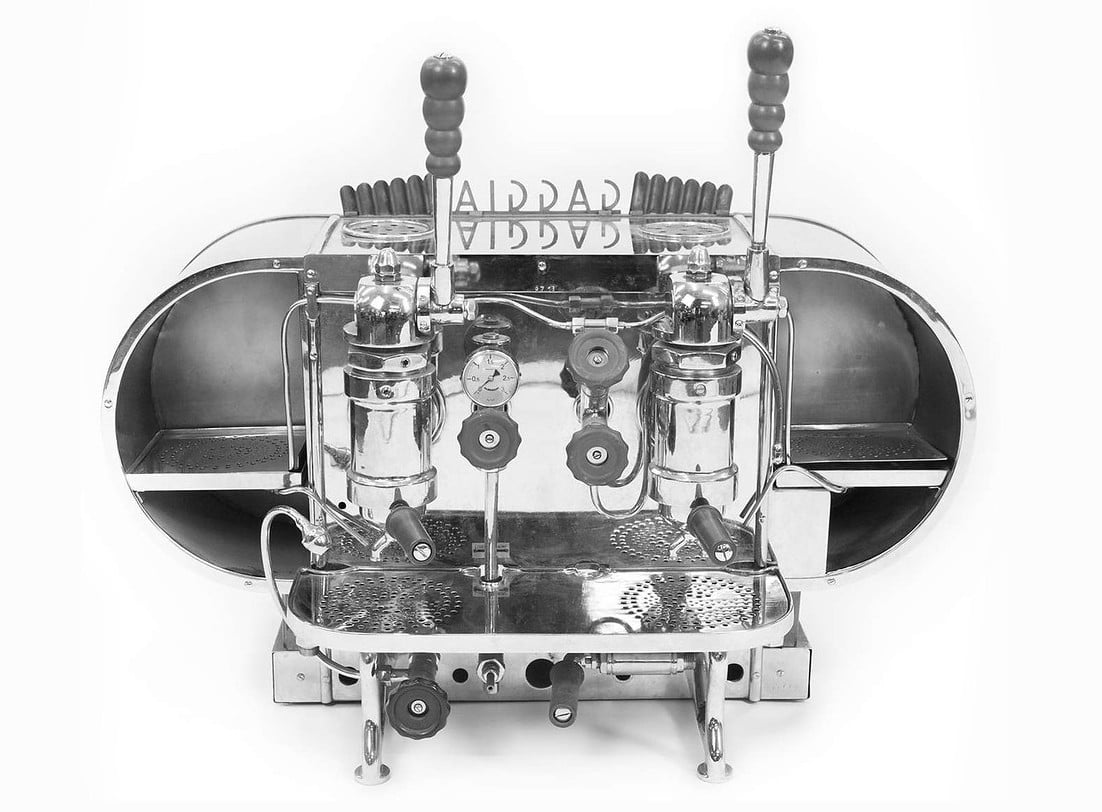
Espresso with crema and the espresso machine have come to be the spiritual and aesthetic heart of a variety of subtly different institutions:
The street coffee sellers, caffè (Italian), cafés (English), coffeehouses, espresso bars, and espresso carts of the world have created a variety of coffee. For espresso is a quintessentially public coffee. The technological evolution of the espresso system only could have evolved in the context of public establishments with enough coffee drinkers to support the expense involved in buying and maintaining such large and complex coffee-making equipment.
The arrival of the crema caffè style of espresso marked not only the creation of a distinctive Italian-style coffee, but also the institution of a “drinking-out” culture, based on the fact that coffee prepared outside the home now tasted very different from that made with a Moka or Napoletana.
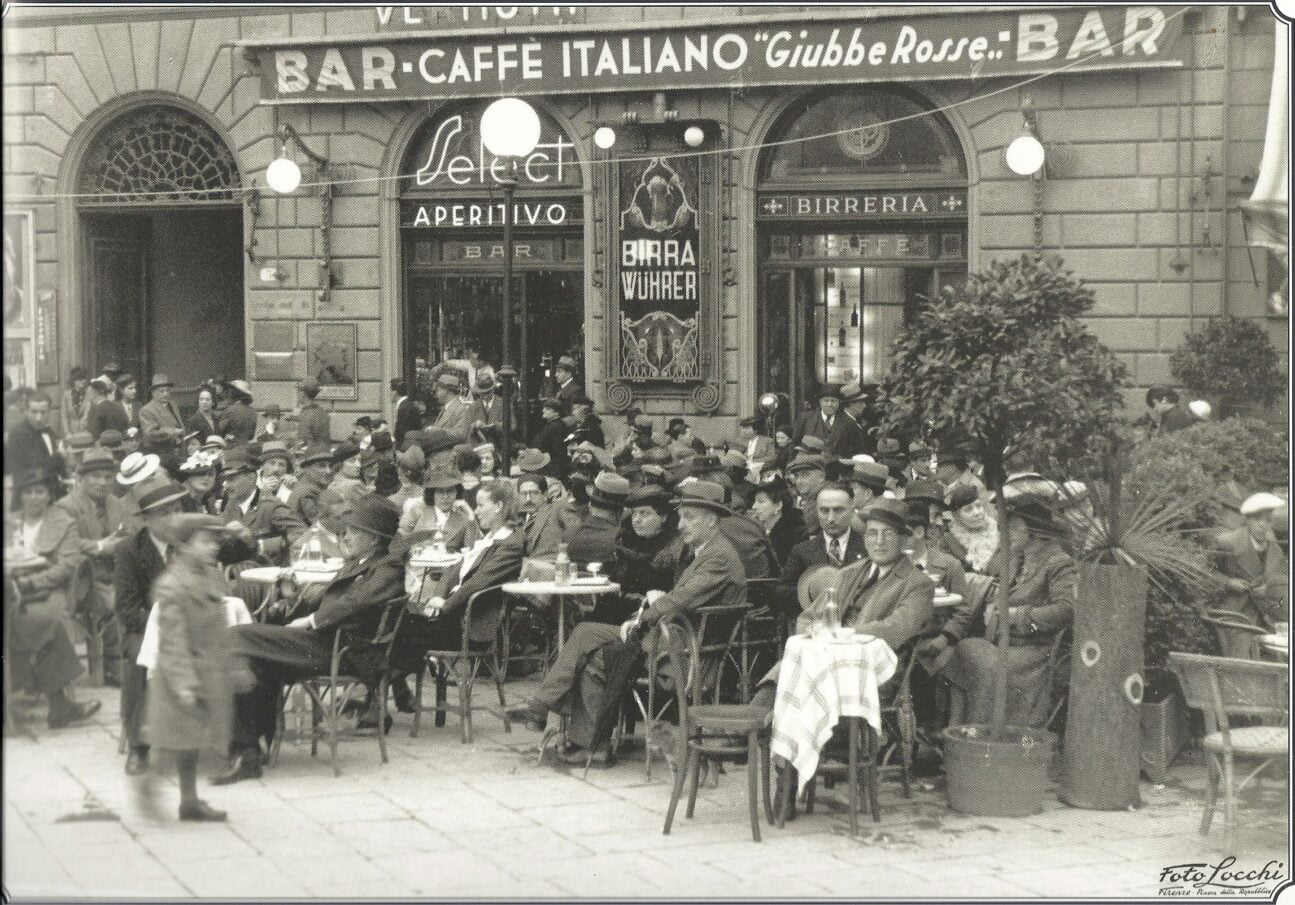
Of course, such establishments were by their nature frequented by those who had either the time or the money. Whereas coffee in the grand cafés was served by waiters to seated guests at a table, in the bar the clientele stood on one side of the counter and purchased drinks from an attendant who served them from the other.
The Caffè Manaresi, opened in Florence in 1898, is reputed to have been the first such bar in Italy, and was nicknamed “Caffè dei Ritti” (ritto- standing straight) by locals because the patrons consumed their beverages standing up. The espresso machine stood on the counter facilitating this faster “express” service. Caffè Manaresi still exists, they are specialized coffee roasters.
Today many establishments have standing-room-only areas, encouraging clients to converse while enjoying their drinks.
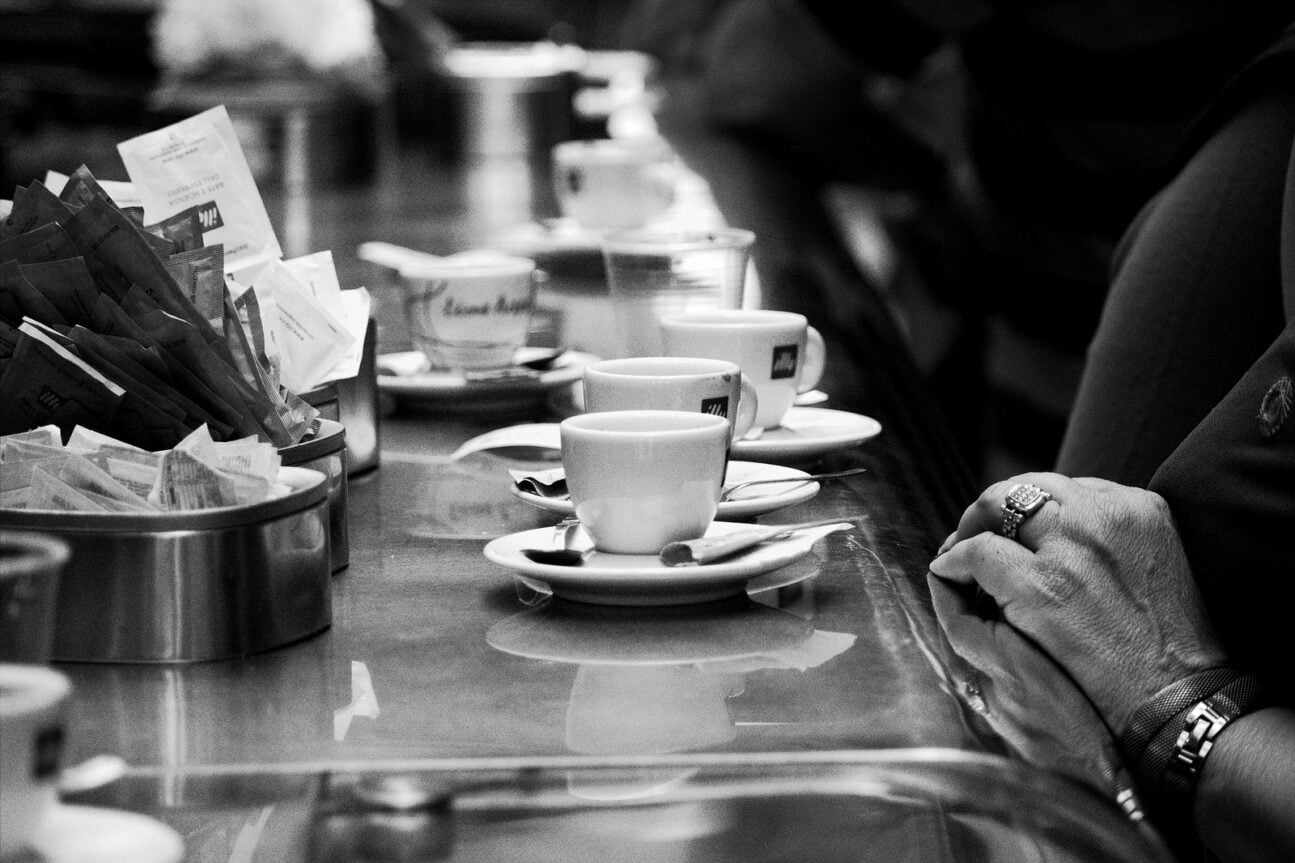
BAR: A symbol of Italian culture
The bar became a second home to us: Embracing the rich history, vibrant atmosphere, and unparalleled passion of Italian coffee culture.

Types of Bars and Caffé

Bar is a place with a wide selection of both alcoholic and non-alcoholic drinks as well as coffee, cappuccino, sweet carbs, like “cornetti” and other typical local pastries and savory foods (panini, tramezzini, pasta and pizzetta for lunch) are available. A bar can also have spaces for consumption, inside or outside the establishment and is considered in Italian culture as a place for meeting and entertaining, especially during the day and pre-evening hours for an aperitivo – aperitif.
For breakfast, many town dwelling Italians took little beyond coffee in the morning, before visiting the bar for a breakfast of cappuccino and a cornetto (croissant) on the way to work or in the first break.
Factories and large offices might set up a bar interno (internal bar) for the refreshment of workers. For others, the coffee break was usually taken in the nearest bar, facilitated by the fact that the short time necessary to consume an espresso could not provide the pretext for a significant interruption of productive activity.
Coffee has … expand[ed] humanity’s working-day from twelve to a potential twenty-four hours. The tempo, the complexity, the tension of modern life, call for something that can perform the miracle of stimulating brain activity, without evil, habit-forming after-effects.
Margaret Meagher, To Think of Coffee (1942)
The “Italian bar” is also a place for leisure time, to read the newspaper, to watch sports on TV (Bar-Sport), to chat with friends or to play cards. It sometimes has the commercial function of a tobacco shop (Bar-Tabaccheria), a pastry shop (Bar- Pasticceria) and also an ice cream parlor (Bar- Gelateria).

The elegant lounge bar, also called cocktail bar is found in hotels, airports and neighborhoods. More than a mere drink dispensary, the bar now is a place where regular customers gather to tell stories, enjoy music, dance, and share meals in addition to “drink.”
Certainly beer and wine are a powerful draw, but sociability is the principal goal of bar life. Since 2011 bars in Italy can even be open 24 hours a day, making them timeless spaces of consumption, connection, and community.
The latest trends want the bar to be increasingly thematic, the vegan bar, manga bar, gay bar and up to the esoteric “secret bars” accessible to a few – Making the bar a place where communities are formed and can meet.
Bars are about work, too: Changing working practices, including the growth of freelancing, mobile working and the gig economy have been repeatedly identified as important drivers of demand for space in public to work and have informal business meetings. People armed with their laptop or tablet sit in bars and use the coffee shops as an alternative work-, and office space – coffices – a new name for a new lifestyle.
Bars offer guests a space for socialization, whether this is, a fast breakfast with caffé and brioche (called cornetto from Rome down the peninsula) as part of a short coffee break during the course of the working day, a digestive café taken after the main meal (often eaten at home), or rest and relaxation during the evening – the after-work aperitif.

Etymology of the Italian word BAR
For Massimo Arcangeli, linguist, literary critic and writer, the first time the word bar is found in a 1897 dictionary, in the meaning close to that of today as:
“locale per il rapido consumo di dolci, panini, bevande e sim.”
“local for the quick consumption of sweets, sandwiches, drinks and similar.”
Vocabolario milanese-italiano, Paravia, Torino 1897.
The word “bar”, as a place serving drinks, is of uncertain etymology and there are different fascinating interpretations:
Etym-online explains the term “bar” referring to a place where drinks were served on a counter and dates it back to the 1590s.
Although there are several slightly different hypotheses, the most accredited is that the word bar comes from late Latin (bar) and in the late 12th. century, came in use again as a”stake or rod of iron used to fasten a door or gate,”.
The two words for long metal object and the drinking establishment seem to be related, and the second meaning actually derives from the first. The reason should be obvious to anyone who has seen the long metal bar traditionally running along the length of the counter where drinks are served. One for the feet and the other one for the elbows. So this bar(s) became the name of the whole establishment.
The next theory derives from the custom, in the ancient taverns, to separate the corner dedicated to the sale of alcohol with a bar – a barrier, that ended up indicating the place itself.
Another possibility, is that the original meaning was barred, in the sense that, the entrance to the alcohol area was prevented, a custom very typical of the English-speaking world. Where English legislation, in the 19th century, prohibited its consumption, on the doors boards with the inscription “sbarred” were nailed.
It is also claimed, that the concept of the bar referred to the physical separation between the seller of alcohol and customers.
Furthermore, the word BAR is not the acronym of beer and alcohol room; That is a hoax.
BAR – Banco A Ristoro
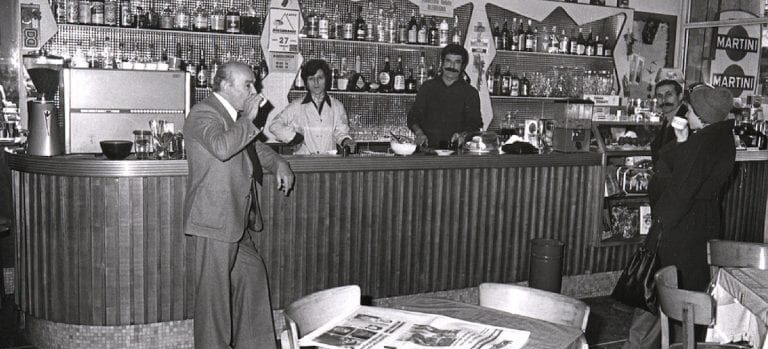
The first to use the word “BAR” (and probably also to invent it) seems to have been an Italian entrepreneur, Alessandro Manaresi, who in 1898 opened the first “BAR” in Florence using the three letters as the acronym for “Banco A Ristoro”(refreshment counter).
In Italy, however, the use of the term “bar” differs a lot from English-speaking countries because it is a cafè. It could therefore be assimilated to the concept of a counter that still today divides the barista and his work area from the customer.
The many Italian names for bar
As a result of a Fascist campaign for the Italianization of minority peoples and foreign words, starting in the 1920s to the end of the war in 1945, the word barman has been traduced as mescitore – pourer and the bar as – bara, ber, bettolino, caffè, liquoreria, taberna potoria, taverna (1941).
Historian Jonathan Morris states, that it seems probable that “barista” has been coined during fascist times, and that oral history suggests that, following the fall of Fascism, the term barman regained popularity in the 1950s and 1960s.
Antonio Zoppetti, an Italian essayist, and student of linguistics and the interference of English in the Italian language, says:
“ Most of the condemned words were French terms, simply because they were much more widespread, while among the English words Monelli admitted some terms such as bar and barista, because they had been in use for more than one generation.
Tramezzino was used instead of sandwich and a brioche was a brioscia.“
Antonio Zoppetti
Paolo Monelli a Giovanni Gentile under the Fascist government led by Benito Mussolini, try to eliminate foreign phrases,names and words and replace them with words that fell into disuse with the fall of the regime. The policy was violently and sometimes grotesquely imposed. One of the most notably absurd and cumbersome examples of this Italianization was the use of bevanda arlecchina (literally meaning “Harlequin beverage”) for cocktails. In other cases, the regime led to changes that still exist today in the modern Italian language, for example the term tramezzino (a type of sandwich).
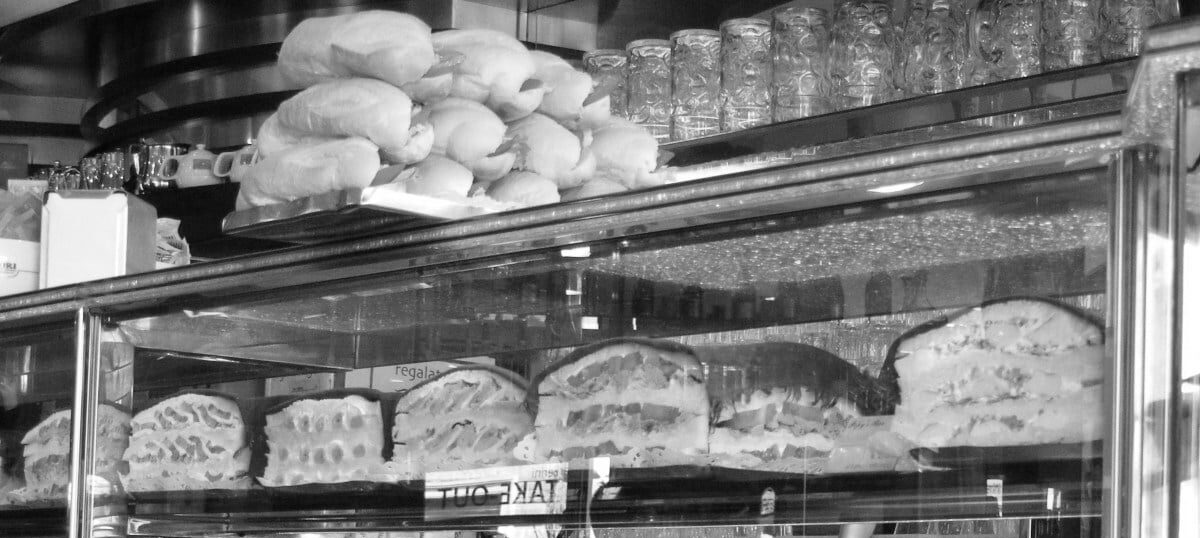
The regime made drastic changes by enacting various measures, against Tirolean and Slavic minorities in Italy, and laws that were designed to enforce the obligatory Italianization of proper nouns, names of places, sports, celebrities, drinks and any name that was perceived foreign.
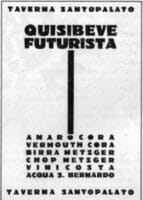
With the futurist manifesto of poet, soldier, politician and writer Filippo Tommaso Marinetti (1876-1944), new Italian terms are also proposed to replace foreign terms such as “cocktail”, which should become “polibibita“, or the “bar” which becomes “quisibeve“, the “sandwich” “traidue“.
So speaking in futuristic terms, let’s imagine going to the quisibeve (literally hereyoudrink) and ordering a fresh polibibita (polydrink) from the mescitore (literally mixer– barman), after a quick look at the lista (literally list).
The Menu of the futurist tavern “Quisibeve Futurista, Santopalato” in the picture.
Coffee in Italy after WWII
During World War II (1939-1945), not only words disappeared but also coffee. It was replaced by surrogates like barley and chicory – as a consequence of the embargo that the League of Nations imposed on fascist Italy. Many Italian children first tasted coffee in the soluble version that US soldiers brought, along with chewing gum, chocolate bars, and packed and branded food items. Coffee didn’t return to Italy’s grocery shelves until 1946. After a caffeine drought of nearly seven years, Italians were more than ready to renew an enduring romance with their favorite beverage.
So milk and dairy shops began brewing coffee and serving drinks. Eventually, they turned into local bars, as small and simple as the grand cafés were large and luxurious. Many bars added tramezzini or panini (sandwiches) and pastries, and other dishes to their coffee. These local bars are still family run, in the same location for decades.

The “bar” transformed to a popular destination, where a cross- section of society including politicians, actors, artists and people from all walks of life met and thrived.
With the economic boom, the pace of life changed and with it the habits. As people started to spend less time on breakfast at home, they found their espresso or cappuccino at the “bar” on their way to work.
In the 1950s and 1960s there was an intriguing resonance between Habermas’ argument that civil society, and modern participatory democracy, emerged from the coffee-house and the post-war effort to rebuild European democracy. Jürgen Habermas is a German sociologist and philosopher (born 1929).
These resonances were intensified by the coffee-house culture of espresso bars and cafés, which had transformed European culture in Habermas’s own time. Perhaps for the first time since the early 18th century, the idea of the coffee-house could be once again credibly associated with a reforming and convivial sociability. Markman Ellis, Professor of Eighteenth-Century Studies, says in: The Coffee House: A Cultural History.
Italian Bar culture
There are about 150,000 “bars” in Italy (149.154 according to data from FIPE, the Italian Federation of Public Exercises) each serving about 175 cups of coffee every day and that’s only counting simple espressi. This shows the deep fondness we Italians possess for coffee, a shared and a magical moment.
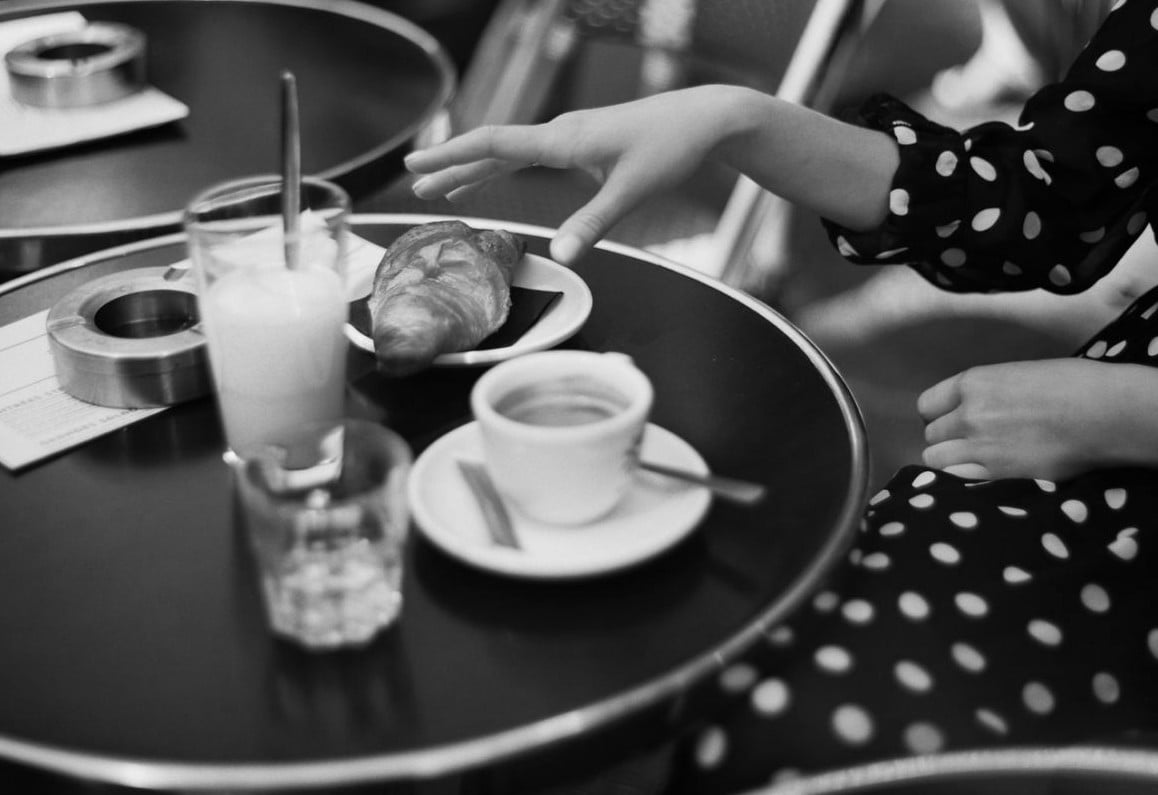
Each bar is unique, reflecting the personality of its baristas, patrons, and surrounding community. The history of the “bar” has followed the evolution of Italian society, capturing changes and innovations.
A bar is a place of long stops, like an English club; but it is also a place of fast passages, like a Chinese market. It’s the place where, while drinking an espresso, you decide on business or about how to pass the evening, about the beginning of a cooperation or the end of a love.
Severgnini Beppe, La testa degli italiani. 2005.
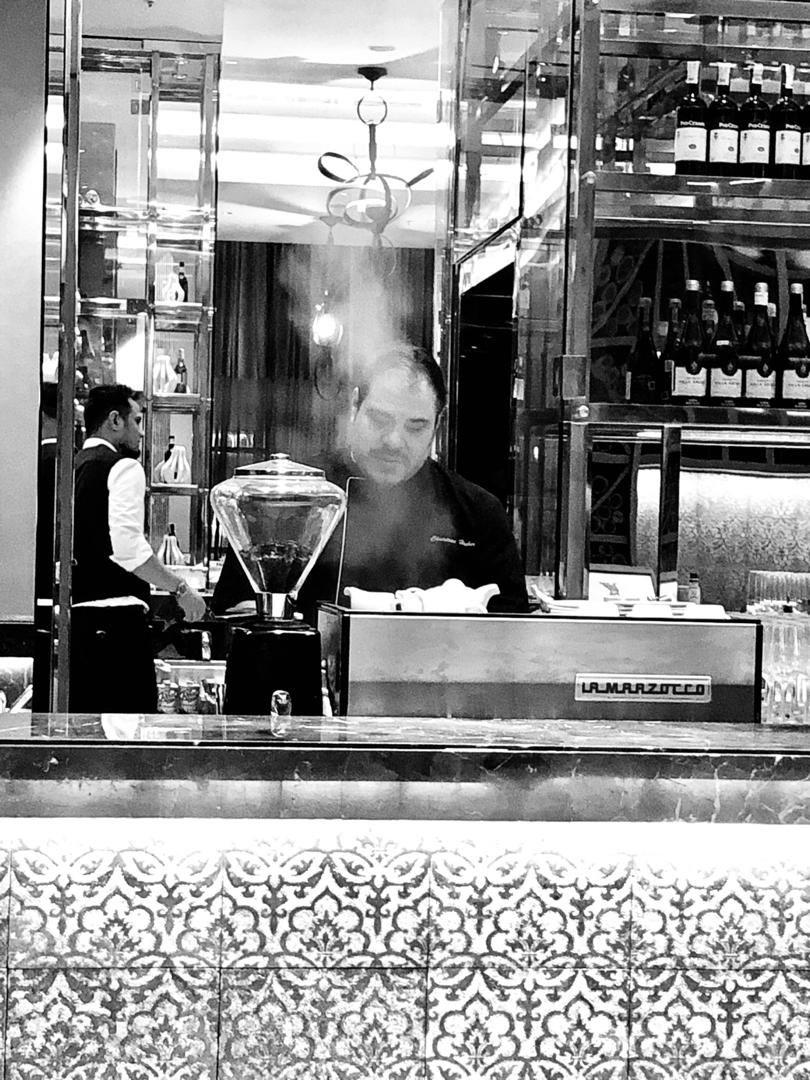
Italian bar culture is made of coffee lovers and an Italian espresso machine, a counter, a barista, and the sound of a tazzina (coffee cup) resting on the saucer.
Of course, it is much more than that. People go to a café to do business, to meet others, to dream or to work. Time is less constrained here, and exchanges are free. So free, in fact, that coffeehouses aroused the suspicion of the religious and political authorities when they first appeared in the 16th century. Nevertheless, they started to spring up in cities from Venice to New York, from Ottoman coffeehouses to Vienna, from Addis Ababa to Bombay.
Frequented by Bohemian artists and favored by writers, some establishments have even entered into legend. Despite being shaken up by the arrival of new global players and having to adapt to changes in consumer habits and the arrival of screens, bars and cafés continue to play a crucial role in community life.
The café might no longer be the place par excellence where ideas are shared, debated, shaken and disseminated, but it remains the best place to form opinions.
Jean-Michel Djian, journalist, curator of the Café In exhibition at the Museum of Civilizations of Europe and the Mediterranean (Mucem) in Marseille (France) in 2016, says:
There is no censorship in a café, the space of freedom and sociability it offers is unique in the annals of humanity
Jean-Michel Djian

~ ○ ~
Keep exploring:
Works Cited & Multimedia Sources
The history of coffee is an extraordinary study. If you would like to learn more about it, I heartily recommend the book, All About Coffee, by William Ukers. Written in 1928, it will delight you with detail.
- https://web.archive.org/web/20070209232239/https://www.venetia.it/s_proc_eng.htm
- it.wikiquote.org (https://it.m.wikiquote.org/wiki/Voci_e_gridi_di_venditori_napoletani)
Voci e gridi di venditori napoletani - http://90905.homepagemodules.de/t155f59-Cappuccino-Kapuziner-Melange-oder-wie-jetzt.html
- https://en.wikipedia.org/wiki/Caff%C3%A8_sospeso
- Allegra World Coffee Portal www.worldcoffeeportal.com
- Artusi Pellegrino. Science in the Kitchen and the Art of Eating Well, transl. Murtha Baca and Stephen Sartarelli. 2003.
- Biderman Bob. A people’s history of coffee and cafés. 2013.
- Café Culture Magazine www.cafeculturemagazine.co.uk
- Carosello Bialetti: la caffettiera diventa mito https://www.famigliacristiana.it/video/carosello-bialetti-moka-mito.aspx
- Cociancich Maurizio. Storia dell’ espresso nell’Italia e nel mondo. 100% Espresso Italiano. 2008.
- Comunicaffe International www.comunicaffe.com
- Davids Kenneth. Espresso Ultimate Coffee. 2001.
- De Crescenzo Luciano. Caffè sospeso. Saggezza quotidiana in piccoli sorsi. 2010.
- De Crescenzo. Luciano. Il caffè sospeso.
- Eco Umberto. “La Cuccuma maledetta” in Agostino Narizzano, Caffè: Altre cose semplici. 1989.
- Ellis Markman. The Coffee House: A Cultural History. 2004.
- Global Coffee Report www.gcrmag.com
- Gusman Alessandro. Antropologia dell’olfatto. 2004.
- Hippolyte Taine, wrote in, Italy: Florence and Venice, trans J. Durand. 1869.
- https://www.italienaren.org/tradizioni-italiane-caffe-in-ginocchio/
- http://www.archiviograficaitaliana.com/project/322/illycaff
- http://www.baristo.university/userfiles/PDF/INEI-M60-ENG-Public-Regulation-EICH-v4-1.pdf
- http://www.coffeetasters.org/newsletter/en/index.php/category/a-baristas-life/
- http://www.coffeetasters.org/newsletter/it/index.php/il-galateo-del-caffe/01524/
- http://www.culturaacolori.it/fascismo-contro-le-parole-straniere/
- http://www.espressoitaliano.org/en/The-Certified-Italian-Espresso.html
- http://www.inei.coffee/en/Welcome.html
- https://archiviostorico.fondazionefiera.it/entita/585-bialetti-industrie
- https://bialettistory.com/
- https://cdn.intechopen.com/pdfs/55623.pdf Severini Carla. Derossi Antonio. Ricci Ilde. Fiore Anna Giuseppina. Caporizzi Rossella. How Much Caffeine in Coffee Cup? Effects of Processing Operations, Extraction Methods and Variables
- https://en.wikipedia.org/wiki/Drip_coffee#Cafeti%C3%A8re_du_Belloy
- https://en.wikipedia.org/wiki/ISSpresso
- https://en.wikipedia.org/wiki/Italian_meal_structure
- https://en.wikipedia.org/wiki/Neapolitan_flip_coffee_pot
- https://hal.science/hal-00618977/document
- https://hub.jhu.edu/magazine/2023/spring/jonathan-morris-coffee-expert/
- https://ineedcoffee.com/the-story-of-the-bialetti-moka-express/
- https://it.wikipedia.org/wiki/Caff%C3%A8
- https://it.wikipedia.org/wiki/Caff%C3%A8#Risvolti_etici_e_sociali
- https://it.wikipedia.org/wiki/Napoletana
- https://italofonia.info/la-politica-linguistica-del-fascismo-e-la-guerra-ai-barbarismi/
- https://italysegreta.com/italian-hospitality-the-invite/
- https://library.ucdavis.edu/wp-content/uploads/2022/06/LangPrize-2017-ElizabethChan-Project.pdf
- https://memoriediangelina.com/2009/08/11/italian-food-culture-a-primer/
- https://mostre.cab.unipd.it/marsili/en/130/the-everyday-eighteenth-century
- https://napoliparlando.altervista.org/cuccumella-la-caffettiera-napoletana/
- https://specialcoffeeitaly.com/barista-espresso-coffee-machine/
- https://specialcoffeeitaly.com/italian-breakfast-cappuccino-cornetto/?_gl=1*1gjfoya*_ga*OTE0MDM2ODM5LjE2OTMzNjE5OTg.*_ga_2HTE5ZB0JS*MTY5MzM2MTk5Ny4xLjEuMTY5MzM2Mjk0NS4wLjAuMA../
- https://specialcoffeeitaly.com/what-came-first-the-italian-bar-or-coffee/
- https://themokasound.com/
- https://uwyoextension.org/uwnutrition/newsletters/understanding-different-coffee-roasts/
- https://www.adir.unifi.it/rivista/1999/lenzi/cap2.htm
- https://www.bialetti.co.nz/blogs/making-great-coffee/using-bialetti-coffee-makers
- https://www.bialetti.com/ee_au/our-history?___store=ee_au&___from_store=ee_en
- https://www.bialetti.com/it_en/inspiration/post/ground-coffee-for-moka-should-never-be-pressed
- https://www.brepolsonline.net/doi/pdf/10.1484/J.FOOD.1.102222
- https://www.coffeeartproject.com/TheCollection/Amsterdam/2014.aspx
- https://www.coffeeartproject.com/TheCollection/Amsterdam/2014.aspx
- https://www.coffeeartproject.com/TheCollection/Milan/2013/Gallery/Other/Amalia-Chieco
- https://www.coffeeartproject.com/TheCollection/NewYork/2016.aspx
- https://www.coffeeartproject.com/TheCollection/NewYork/2017.aspx
- https://www.coffeeartproject.com/TheCollection/NewYork/2018.aspx
- https://www.coffeeartproject.com/TheCollection/NewYork/2019.aspx
- https://www.coffeeresearch.org/science/aromamain.htm
- https://www.coffeereview.com/coffee-reference/from-crop-to-cup/serving/milk-and-sugar/
- https://www.comitcaf.it/
- https://www.ecf-coffee.org/wp-content/uploads/2023/05/European-Coffee-Report-2022-2023.pdf
- https://www.espressoitalianotradizionale.it/
- https://www.euronews.com/culture/2022/02/15/the-italian-espresso-makes-a-bid-for-unesco-immortality
- https://www.faema.com/int-en/product/E61/A1352IILI999A/e61-legend
- https://www.finestresullarte.info/en/works-and-artists/the-bialetti-moka-the-ultimate-romantic-design-object
- https://www.finestresullarte.info/opere-e-artisti/moka-bialetti-oggetto-design-ultimi-romantici
- https://www.freemalaysiatoday.com/category/leisure/food/2022/02/15/italy-woos-unesco-with-magic-coffee-ritual/
- https://www.gaggia.com/legacy/
- https://www.gamberorossointernational.com/news/coffee-10-false-myths-to-dispel-on-the-beverage-most-loved-by-italians/
- https://www.gcrmag.com/calls-to-review-price-structure-of-italian-espresso/
- https://www.granaidellamemoria.it/index.php/it/archivi/caffe-espresso-italiano-tradizionale
- https://www.illy.com/en-us/coffee/coffee-preparation/how-to-make-moka-coffee
- https://www.illy.com/en-us/coffee/coffee-preparation/how-to-use-neapolitan-coffee-maker
- https://www.ilpost.it/2011/06/08/itabolario-bar-1897/
- https://www.itstuscany.com/en/bar-where-the-word-comes-from/“Cafe Hawelka”, John A. Irvin
- https://www.lastampa.it/verbano-cusio-ossola/2016/02/17/news/le-ceneri-di-renato-bialetti-nella-sua-moka-con-i-baffi-1.36565348/
- https://www.lavazza.com/en/coffee-secrets/neapolitan-coffee-maker
- https://www.lavazzausa.com/en/recipes-and-coffee-hacks/making-espresso-at-home
- https://www.linkedin.com/pulse/third-wave-coffee-meets-tradition-neapolitan-maker-bruno-lopez
- https://www.mumac.it/we-love-coffee-en/be-our-guest-en/progettazione-e-rito/?lang=en
- https://www.quartacaffe.com/images/pdf/carta-dei-valori.pdf
- https://www.repubblica.it/il-gusto/2021/07/26/news/caffe_il_piu_clamoroso_equivoco_gastronomico_d_italia-311835974/
- https://www.taccuinigastrosofici.it/ita/news/contemporanea/semiotica-alimentare/print/Pop-cibo-di-sostanza-e-circostanza.html
- https://www.thehistoryoflondon.co.uk/coffee-houses/
- https://www.wien.gv.at/english/culture-history/viennese-coffee-culture.html
- Illy Andrea. Viani Rinantonio. Furio Suggi Liverani. Espresso Coffee. The Science of Quality. 2005.
- International Coffee Organization www.ico.org
- Kerr Gordon. A Short History of Coffee. 2021.
- La cremina per il caffè: come farla bene. https://www.lacucinaitaliana.it/news/cucina/come-fare-la-cremina-del-caffe/
- Allen Lee Stewart. Devil’s Cup. A History of the World According to Coffee. 1999.
- Leonetto Cappiello – Wikipedia page on the creator of the 1922 poster La Victoria Aduino.
- Markman Ellis. The Coffee House. A Cultural History. 2005.
- Mennell Stephen. All Manners of Food. Eating and Taste in England and France. 1996.
- Montanari Massimo. Il riposo della polpetta e altre storie intorno al cibo. 2011.
- Montanari Massimo. Il sugo della storia. 2018.
- Morris Jonathan. A Short History of Espresso in Italy and the World. Storia dell’espresso nell’Italia e nel mondo. In M. Cociancich. 100% Espresso Italiano. 2008.
- Morris Jonathan. Coffee: A Global History. 2019.
- Morris Jonathan. Making Italian Espresso, Making Espresso Italian.
- Pazzaglia Riccardo. Odore di Caffe’. 1999.
- Pendergrast Mark. Uncommon Grounds. The History of Coffee and How It Transformed Our World. 2019.
- Perfect Daily Grind www.perfectdailygrind.com
- Scaffidi Abbate Mario. I gloriosi Caffè storici d’Italia. Fra storia, politica, arte, letteratura, costume, patriottismo e libertà. 2014.
- Schnapp Jeffrey. The Romance of Caffeine and Aluminum. Critical Inquiry. 2001.
- Sibal Vatika. Food: Identity of culture and religion. 2018.
- Specialty Coffee Association www.sca.coffee
- Spieler Marlena. A Taste of Naples. 2018.
- Tea and Coffee Trade Journal www.teaandcoffee.net
- The Long History of the Espresso Machine. www.smithsonianmag.com
- The Pleasures and Pains of Coffee by Honore de Balzac
- The relaxation ritual https://themokasound.com/
- Tucker, Catherine M. Coffee Culture: Local Experiences, Global Commensality, Society and Cuture 2011.
- World Coffee Research www.worldcoffeeresearch.org

